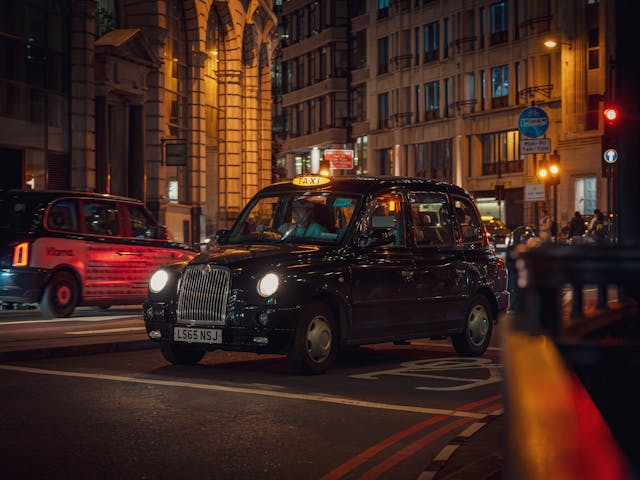
When did we start using taxis? The first taxi service was started in London, UK in 1605.
Just as with buses, it took several changes in society before a taxi service became necessary or possible. Before we look at that, though, let’s look at the origin of the word “taxi”. Taxi is a shortened form of the word taxicab, which is in itself a shortened form of taximeter cabriolet. Taximeter came into English from French and it came into French from German. In German, the word was originally taxameter, which meant “an automatic meter to record the distance and fare”. Cabriolet is a French word that means “a type of covered horse-drawn carriage”. So, a taxi cab is “a covered horse-drawn carriage with an automatic meter to record the distance and fare”.
Carriages that you could hire have existed since the beginnings of civilization. Wealthy people would either own their own carriage or sedan pulled or carried by slaves, or they would hire one to take them somewhere. There are records of people in Rome waiting near popular places to carry someone. It can be debated whether these types of transport could be called taxis or not. They were not available for the average person because they could not afford them. According to a Roman architect writing in 27 BC, there was a system for measuring distance on carts. One of the cartwheels had a toothed cog on it, which was attached to another cog. Every rotation of the cog on the wheel caused the second cog to turn a little. When the second cog turned a complete rotation, which was calculated as a Roman mile, a pebble fell out of a box. The number of pebbles could be counted to measure the distance. There doesn’t seem to be any evidence that this system was used to charge customers.
The first taxi system, meaning vehicles for hire by anyone, was introduced in London in 1605, but it is possible that it started before that. By the late 1500s, wealthy people used horse-drawn carriages to get around town and it wasn’t long before regular people wanted a similar service. They couldn’t afford to buy their own carriage, but they could afford to rent one for a short while. This niche was filled by the new taxi cab industry, called Hackney carriages. Why did the taxi cab industry start then? During the 16th century, the population of the UK, and London in particular, skyrocketed. It almost doubled from 2.2 million in 1500 to 4.1 million in 1600. There were many reasons for this, not least improvements in agriculture, new trade, and new industries. There was a new middle class and these people wanted taxi cabs. In fact, so many Hackney carriages appeared to fill this gap in the market that laws had to be passed limiting the number that could drive on the streets. The first taxi rank was built for them in 1636. They were such a menace to pedestrians that the drivers were forced to get licenses in 1662, beginning the trend of licensing taxi drivers. The number of carriages increased year by year until there were over 1,000 in the city.
In 1834, a man called Joseph Hansom built a much faster two-wheeled version of the Hackney cab, which became known as hansom cabs. They were faster, cheaper, and more agile. They were so popular that they soon replaced the Hackney cab and they spread to other cities around the world. However, by the end of the 19th century, other technologies were starting to replace the horse. The internal combustion engine was a way off, but the steam engine and the electric engine were both viable alternatives. Several electric taxi cabs were built in the style of the hansom cabs. They worked, but they took a long time to charge and they sometimes tipped over. The version in the UK were called Hummingbirds because of the quiet hum they emitted as they moved. All of these vehicles worked on an agreed fee that varied with the distance before setting off.
The modern style of taxi was made possible in Germany in 1891 when Friedrich Wilhelm Gustav Bruhn invented the taximeter. It was a meter that was connected to the car’s wheel and every so many rotations of the wheel made the price displayed on the meter click up one unit. It was first put in a combustion engine automobile in 1897 and the world has never looked back. The taximeter cabriolets spread all over the world. The name was shortened to taxicab, probably in New York, and a new way of paying for a journey was born. And this is what I learned today.
Photo by Mario Spencer: https://www.pexels.com/photo/cab-on-a-street-in-london-19518921/
Sources
https://en.wikipedia.org/wiki/Taxi
https://en.wikipedia.org/wiki/Taximeter
https://en.wikipedia.org/wiki/Hackney_carriage
https://www.motorcities.org/story-of-the-week/2018/a-brief-history-of-taxicabs-1907-1968
https://www.etymonline.com/word/taxi
https://www.etymonline.com/word/cab
https://ourworldindata.org/grapher/population-of-england-millennium

Pingback: #223 What did the Magna Carta do?